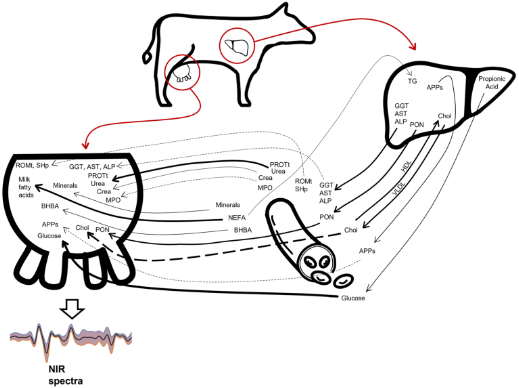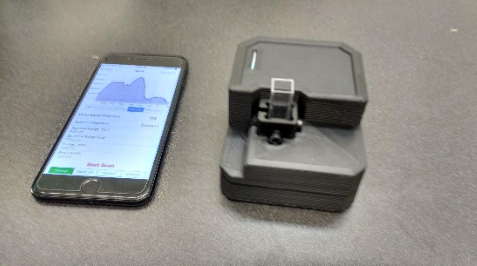In dairy cows, Hyperketonemia (HYK) is a disease defined as abnormally high concentration of ketone levels, mainly Beta Hydroxy-Butyrate (BHB)¹. The concentrations greater than 1.4 mmol/L are generally accepted as the onset of HYK and are associated with increased risks of clinical ketosis (burning fat instead of carbohydrates for energy and producing ketones), decreased conception rates and decreased milk production in dairy cows¹. HYK depends on BHB levels in blood and therefore blood analysis is a gold standard for its diagnosis. Figure 1 shows the process of blood sampling in cows which is not very convenient for the animal.

Continuous blood sampling of animals who are at risk is not feasible because it is a labour- intensive procedure which causes distress in cows². Besides, laboratory analysis of samples is expensive which makes the process even more unfeasible. Obtaining the metabolites from milk and establishing an inline monitoring system is more practical and less labour intensive. FTIR measurement of BHB has been done by researchers¹. The idea is that specific milk molecules will absorb specific IR radiation and by chemometric modelling of the absorption spectra, one can identify or quantify the ingredient. IR predictions of ketone in bodies using FTIR have a relatively low accuracy of 0.71 but they can still be used to predict the occurrence of Clinical Ketosis (CK)¹.
Near infrared spectroscopy is also another method of analyzing cow milk for metabolites. After scanning the milk samples, specific chemical bonds absorb specific wavelengths and produce an absorption profile which is made of absorbance values for individual near-IR wavelengths associated with milk components. Near-IR spectroscopy has certain advantages over the FTIR method including rapidity of acquisition, cost effectiveness, and continuous reading. Ability to measure particle size through scattering and no need for taking repeated reference measurements².
Other metabolites in blood can also be predicted by Milk NIR measurements such as glucose, total cholesterol and urea (r>0.6) and BHBA (r=0.54)².
Figure 2 shows the correlation of metabolites in cow’s blood to cow’s milk.

Aside from the above-mentioned metabolites, Near IR spectroscopy can capture the presence of minerals such as sodium, zinc, calcium, phosphorus and magnesium. These minerals do not have specific absorption bands in the near-IR spectrum so predicting them is related to their occurrence in organic molecules or the effect of the element on water absorption bands. In other words they act as a proxy.
In one study², an inline milk analyser system was installed which contained 32 LEDS in the 350-1000 nm. The data was treated with first derivative and Standard Variate (SNV) and Principal Component Analysis (PCA) was used to remove the outliers. The prediction equations were implemented which allowed real-time measurement of metabolic condition of cows multiple times a day. Sub-clinical diseases are defined as those diseases which can be identified using laboratory methods but there are no symptoms that are visible. Using the inline NIR systems, it is possible to monitor sub-clinical diseases.
ASP Laser Inc. offers the transmittance Near-IR spectrophotometer called NIRvascan which is very suitable for this application. Figure 3 shows the unit which requires a glass cuvette for operation and works in the near-IR range of 900-1700 nm. The unit is also capable of being operated with an app with no physical connection.

Milk needs to be poured into the cuvette and the measurement is done in an instant. Since the Software Development Kit (SDK) is provided, one can integrate this device into an inline milk monitoring device and develop a custom app for it. For further information regarding this device, refer to the following link: https://www.alliedscientificpro.com/nirvascan
This spectrophotometer device is advantageous because it collects the full data between 900-1700 nm range and not only at discrete wavelengths. Since it uses Digital Light Processing method to scan (uses a single element detector instead of an expensive array detector), it is also more economical as compared to array detector spectrophotometers.
References:
- Prediction of blood β-hydroxybutyrate content and occurrence of hyperketonemia in early-lactation, pasture-grazed dairy cows using milk infrared spectra V. Bonfatti,1 * S.-A. Turner,2 B. Kuhn-Sherlock,2 T. D. W. Luke,3 P. N. Ho,3 C. V. C. Phyn,2 and J. E. Pryce2, J. Dairy Sci. 102:6466–6476 https://doi.org/10.3168/jds.2018-15988 © American Dairy Science Association®, 2019.
- In-line near-infrared analysis of milk coupled with machine learning methods for the daily prediction of blood metabolic profile in dairy cattle DianaGiannuzzi1*, Lucio Flavio Macedo Mota1 , Sara Pegolo1 , LuigiGallo1 , Stefano Schiavon1 , FrancoTagliapietra1 , Gil Katz2 , David Fainboym2 , Andrea Minuti3 , ErminioTrevisi3 & Alessio Cecchinato, Nature, Scientifc Reports | (2022)